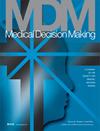传播 COVID-19 快速抗原自我测试的不完全诊断准确性:在线随机试验
IF 3.1
3区 医学
Q2 HEALTH CARE SCIENCES & SERVICES
引用次数: 0
摘要
目的研究优化冠状病毒病 2019(COVID-19)快速抗原检测(RAT)自我检测诊断准确性信息的潜在影响。设计使用假设情景进行在线随机试验:在情景 1 至 3(RAT 结果为阳性)中,测试后的概率被认为非常高(可能为真阳性);在情景 4 和 5(RAT 结果为阴性)中,测试后的概率被认为中等偏上(可能为假阴性)。干预:以对健康素养敏感的方式展示 COVID-19 自我 RAT 的诊断准确性;常规护理:由制造商提供诊断准确性信息;对照:不提供诊断准确性信息.主要结果测量自我隔离的意向.结果共有 226 名参与者被随机分组(对照组 n = 75,常规护理组 n = 76,干预组 n = 75)。干预组中有更多参与者正确理解了诊断准确性信息的含义(对敏感性的理解为 P = 0.08,对特异性的理解为 P < 0.001)。在情景 1 至 3 中,自我隔离的比例相似(可能为真阳性)。在情景 4 和 5 中,干预组的比例高于对照组(可能为假阴性)。这些差异没有统计学意义。最大的潜在影响出现在情景 5 中(有确诊病例的晚宴,患者有症状,自我 RAT 结果为阴性),63% 的干预组和 49% 的对照组表示他们会进行自我隔离(绝对差异为 13.3%,95% 置信区间:-2% 至 30%,P = 0.10)。这可能会增加社区在自我RAT结果可能为假阴性时进行自我隔离的意愿。试验注册:澳大利亚-新西兰临床试验注册中心 (ACTRN12622001517763)摘要基于社区的 COVID-19 自我RAT诊断准确性研究表明,与大多数政府公共网站上制造商提供的信息相比,COVID-19 自我RAT的灵敏度要低得多(假阴性结果的风险也更高)。这项在线随机研究发现,对诊断准确性不完善的 COVID-19 SelfRATs 进行对健康素养敏感的介绍有助于参与者理解和回忆诊断准确性信息。在检测结果为阴性后,如果检测后的概率仍然很高(即可能出现假阴性结果),对健康知识敏感的介绍可能会提高社区自我隔离的意愿。为防止感染的继续传播,亟需努力加强有关 COVID-19 自我 RAT 检测假阴性结果高风险的宣传。本文章由计算机程序翻译,如有差异,请以英文原文为准。
Communicating the Imperfect Diagnostic Accuracy of COVID-19 Rapid Antigen Self-Tests: An Online Randomized Experiment
ObjectiveTo investigate the potential impacts of optimizing coronavirus disease 2019 (COVID-19) rapid antigen test (RAT) self-testing diagnostic accuracy information.DesignOnline randomized experiment using hypothetical scenarios: in scenarios 1 to 3 (RAT result positive), the posttest probability was considered to be very high (likely true positives), and in scenarios 4 and 5 (RAT result negative), the posttest probability was considered to be moderately high (likely false negatives).SettingDecember 12 to 22, 2022, during the mixed-variant Omicron wave in Australia.ParticipantsAustralian adults. Intervention: diagnostic accuracy of a COVID-19 self-RAT presented in a health literacy-sensitive way; usual care: diagnostic accuracy information provided by the manufacturer; control: no diagnostic accuracy information.Main Outcome MeasureIntention to self-isolate.ResultsA total of 226 participants were randomized (control n = 75, usual care n = 76, intervention n = 75). More participants in the intervention group correctly interpreted the meaning of the diagnostic accuracy information ( P = 0.08 for understanding sensitivity, P < 0.001 for understanding specificity). The proportion who would self-isolate was similar across scenarios 1 to 3 (likely true positives). The proportion was higher in the intervention group than in the control for scenarios 4 and 5 (likely false negatives). These differences were not statistically significant. The largest potential effect was seen in scenario 5 (dinner party with confirmed cases, the person has symptoms, negative self-RAT result), with 63% of the intervention group and 49% of the control group indicating they would self-isolate (absolute difference 13.3%, 95% confidence interval: −2% to 30%, P = 0.10).ConclusionHealth literacy sensitive formatting supported participant understanding and recall of diagnostic accuracy information. This may increase community intentions to self-isolate when there is a likely false-negative self-RAT result. Trial registration: Australia New Zealand Clinical Trial Registry (ACTRN12622001517763)HighlightsCommunity-based diagnostic accuracy studies of COVID-19 self-RATs indicate substantially lower sensitivity (and higher risk of false-negative results) than the manufacturer-supplied information on most government public Web sites. This online randomized study found that a health literacy–sensitive presentation of the imperfect diagnostic accuracy COVID-19 self-RATs supported participant understanding and recall of diagnostic accuracy information. Health literacy–sensitive presentation may increase community intentions to self-isolate after a negative test result where the posttest probability is still moderately high (i.e., likely false-negative result). To prevent the onward spread of infection, efforts to improve communication about the high risk of false-negative results from COVID-19 self-RATs are urgently needed.
求助全文
通过发布文献求助,成功后即可免费获取论文全文。
去求助
来源期刊

Medical Decision Making
医学-卫生保健
CiteScore
6.50
自引率
5.60%
发文量
146
审稿时长
6-12 weeks
期刊介绍:
Medical Decision Making offers rigorous and systematic approaches to decision making that are designed to improve the health and clinical care of individuals and to assist with health care policy development. Using the fundamentals of decision analysis and theory, economic evaluation, and evidence based quality assessment, Medical Decision Making presents both theoretical and practical statistical and modeling techniques and methods from a variety of disciplines.
 求助内容:
求助内容: 应助结果提醒方式:
应助结果提醒方式:


